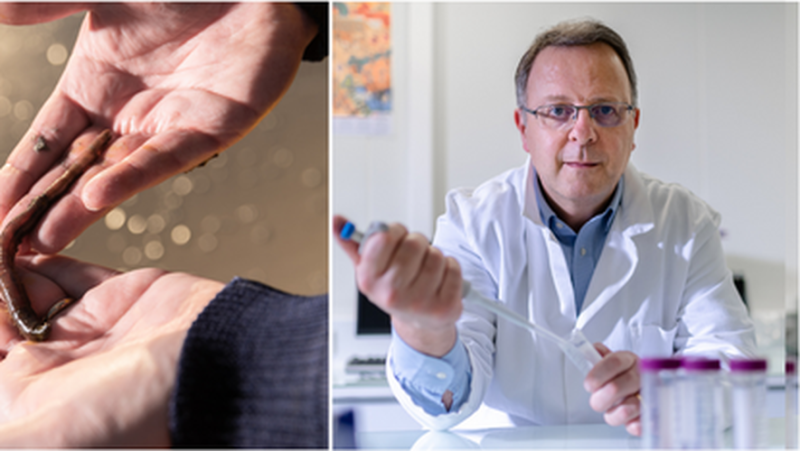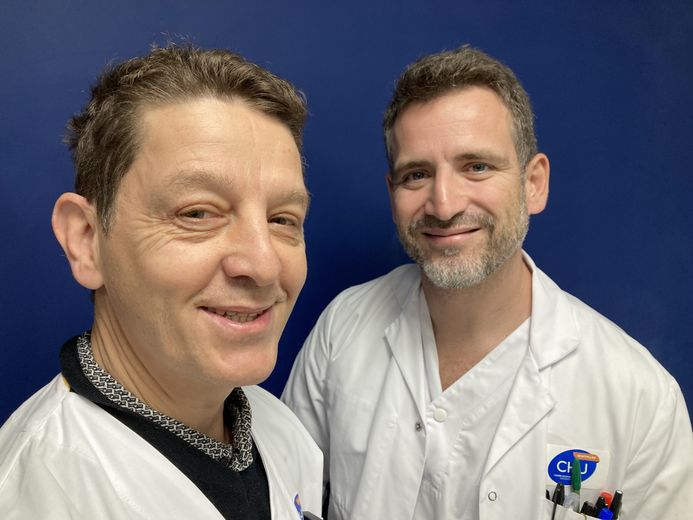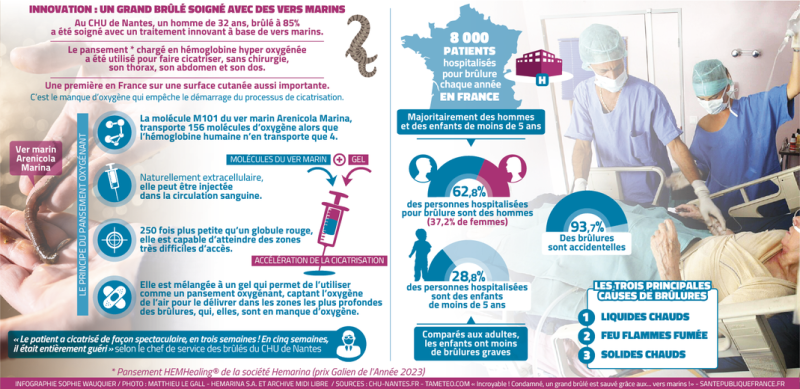Marine worms to treat severe burns: “It will take years”, in Occitania doctors are exploring other avenues

The worms used for the treatment (left) and Franck Zal, the scientist behind the process, today at the head of the start-up Hemarina. PHOTOS DR MATHIEU LE GALL/HEMARINA
Has a start-up from Finistère, Hemarina, found the miracle treatment for severe burns ? The Nantes University Hospital communicated at the end of 2023 on spectacular results obtained on a patient with 83% burns. Professor Christian Herlin, from Montpellier University Hospital, and Dr Alain Frasson, from the Ster clinic (Lamalou-les-Bains) explain the limits of this feat, as they prepare to test a another innovation: three-dimensional skin.
Christian Herlin is head of the plastic, aesthetic and reconstructive surgery department at Montpellier University Hospital. Alain Frasson, coordinating doctor at the Ster clinic (Lamalou-les-Bains), in the rehabilitation department of serious burn victims, are the actors of a coordinated care of serious burn victims unique in Occitanie.

Alain Frasson, coordinating doctor of the burn rehabilitation department at the Ster clinic and Christian Herlin, head of the plastic, aesthetic and reconstructive surgery department at Montpellier University Hospital. PHOTO S.G.
What do you think of the value of marine worms for treating severe burns ?
Christian Herlin: There are not many innovations in burns, there is no revolution. There was, in the 1980s, the artificial dermis, then the graft of keratinocytes (Editor's note: epidermis cells) a little later and which allowed people to be burned on very, very large surfaces. , beyond 80%, to survive while they were condemned.
Since then, not much has happened. The principle of the marine worm, which appeared a few years ago, consists of better oxygenating the tissues with hemoglobin which will provide more oxygen, a bit like a hyperbaric chamber could do. This oxygenation technique is widely used for organ preservation. On burns, it is very recent, and the only test on a large area was actually carried out in Nantes. The person was grafted on the legs and arms, but on the trunk there was a waiting dressing with this technique. We have a lot of these waiting bandages.
That’s ?
There have been numerous tests, with fish skin, beef tendon… we have tried almost everything: elastin, shark… There, this dressing combines the # Hyaluronic acid with sea worm hemoglobin. It was a waiting bandage. But what happened was that, quite surprisingly, on skin that seemed quite deeply affected, we ended up with some scarring. better than expected and quite fast.
It's promising, but we must not be fooled, this is not a revolution: nothing will be born from a desert. You need keratinocytes. The cell that "will" skin cannot appear out of nowhere, so the burn victim's condition must allow it. From a deep second degree burn, there are no more stem cells.
And I remind you that this process is not authorized today. There is a whole study process that will have to be put in place and which can last for years.
"We are going to test an artificial skin in three dimensions"
You could test it ?
I'm going to be completely honest, the next test we're going to do is based on an artificial skin constructed for the first time in three dimensions, developed in a Swiss laboratory.
A few burn centers will test it in France and Germany. These are studies that will take several years, with budgets of several millions. It's not about "making a move" and to say that it's great, but to follow people over time.
How many patients will be affected ?
We will need to treat 250 or 300 patients.
When you say "on", you associate the Ster clinic, which also takes care of severe burn victims ?
Alain Frasson: Yes, we are in a sector here.

Marine worms, a hope for treatment. SOPHIE WAUQUIER
How will this 3D skin work ?
Christian Herlin: When you are 90% burned, you have a very small piece of skin left to cover, from there, the entire body. Until now, we took cells that we dissociated, and we made a kind of spray of cells, which we placed on the wound, so that they colonize the wound to make skin. We didn't have the architecture of the skin.
There, the idea is to have an expansion capacity of "times 100", with one centimeter square of saved skin, we can do 100 square centimeters of reconstructed skin… it's very interesting in terms of the surface area of skin possible to reconstruct.
"Skin is very complex in terms of architecture"
How we "make" ?
With a technique that resembles, I am thinking of that of the marine worm: it will be a mesh based on hyaluronic acid, but here, it will be on a collagen framework.< /p>
Alain Frasson: If it works, it will be the first time that we will have the dermis, and the epidermis, the superficial part which covers the dermis. This project seems interesting to us because beyond helping patients, what is also important is the quality of the scar. If you have skin that is not elastic, if you have a lot of shrinkage problems, your quality of life will not be good. What gives the skin suppleness is the dermis. The epidermis, we know how to do, the dermis, too, but the interest is to combine the two, which is what this project does.
And it will only be for serious burn victims ?
Christian Herlin: Yes, it's a niche product, and that's the big difference compared to the sea worm. But I am not against testing the sea worm, if we have a case, we will try… in addition to other things.
The skin is probably one of the organs that we will be able to synthesize last. It is the largest organ in the human body, one of the heaviest, and one of the most difficult to transplant without having a significant immune reaction, and one of the most complex in terms of architecture: just in the epidermis there are eight layers, and none like it!
"It is estimated that 20% to 30% of people are misguided"
There are a lot of burn victims in Occitanie ?
Alain Frasson: we must speak in terms of the sector in Occitanie, in Lamalou, we receive all patients from the post-hospitalization region at the Montpellier or Toulouse University Hospital, which are the acute centers. We receive around 200 patients per year, serious burn victims who come very early, and people who have embarrassing scars. And we also welcome children.
There are aesthetic, psychological, social, professional harms…
What is the most frequent accident, that of the firefighter ?
Christian Herlin: 85%, it's the domestic accident, the oil, the pressure cooker, the tea, the iron… And also the burning, a school case, and the barbecue in the summer.
And we also have elderly people with third degree burns because the temperature of the shower was not checked.
Alain Frasson: There is an essential message to convey, you must consult a specialized center in the event of a severe burn, center 15 must provide guidance. But today, it is estimated that 20% to 30% of people are misguided.
Franck Zal, founder of Hemarina: “We reconstructed baby skin”
"All that, it's the result of twenty-five years of development", says, enthusiastically, Franck Zal, the founding scientist of & #39;Hemarina, who had dedicated his thesis à Arenicola Marina, a marine worm present on the beaches of the Atlantic and the English Channel.
The first "dressings" which combine h'moglobin from worms, which has powerful healing capabilities. s exceptional oxygen transport, and hyaluronic acid, used in cosmetics against aging, have been ;eacute; formulated five or six years ago, recalls the researcher.
Today, around ten cases of burns have already occurred. été treated via these poultices, "with results that are out of the ordinary", assures Franck Zal. The majority tests have been carried out carried out by surgeon Lanrent Lantieri, plastic surgeon at the Georges Pompidou Hospital, & Paris.
&In Nantes, the bet was much more ambitious. For Franck Zal, it is successful: "We reconstructed baby skin". For him, if we are dealing with “an emerging technology”, it is no less promising. From now on, Hemarina has built &amp;amp;amp;amp;eacute; Noirmoutier an aquaculture farm capable of producing 30 tonnes of arecinole worms per year.
The trials will continue, within the framework of a compassionate protocol, with each time, an express request to the health authorities, pending validation, or no, of the process.
Franck Zal, who indicates that other conditions are concerned, diabetic foot ulcers, bedsores, believes in it : "The next step is industrialization at scale. large scale.
I subscribe to read more




